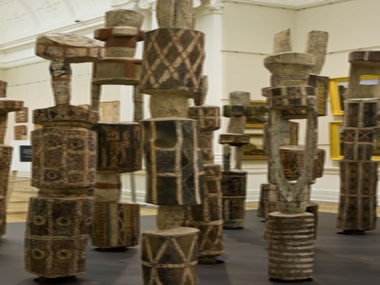COLONIAL TUTINI

Pukumani Poles at the AGNSW by Tiwi artists Laurie Nelson Mungatopi, Bob One Apuatimi, Jack Yarunga, Don Burakmadjua, Charlie Quiet Kwangdini
Posted by Jeremy Eccles | 09.09.09
Gallery: Art Gallery of NSW
Dates:
12.09.09
The Tiwi people who drove the first White colonialists off their remote Melville Island (80kms north of Darwin) less than 5 years after they tried to establish a fort there are enjoying yet more schadenfreude as their ancient burial poles are placed slap bang in the middle of the Colonial art at the Art Gallery of NSW.
This challenging placement of Pukumani Poles (Tutini) and barks up against a work like John Glover's Natives on the Ouse River has the ironic effect of reminding us that this bucolic idyll was in fact the artist's own protest against the clearance of Aborigines out of mainland Tasmania - “an Arcadia they'd fucked up by 1838”, as AGNSW Head of Australian Art, Barry Pearce brutally sums that painting up.
Which is perhaps why other State art galleries have resisted the mixing of black and white art, other than in contemporary competitions like the Clemenger or the Arthur Guy Memorial Painting Prize in Bendigo. Yet Sydney will go on to blend its 20th Century Australian art next year in its shopfront ground floor galleries in a process that kicks off this weekend (12/13th Sept) with a big celebration of the 50th anniversary of the arrival of those Tutini in the city.
Another irony is that the blended Colonial Courts was pretty much what contemporary Aboriginal artist Gordon Bennett proposed for his Sydney Biennale artwork last year – but was refused the opportunity to put it to the test.
And test it is. Phrases like “create an encounter” and “upset the apple-cart” dot Pearce's conversation about the project – which is just capable of being read as showing a progression from 'primitive' barks collected on Groote Eylandt by the expeditioner Charles Mountford in 1948 to the 'sophisticated' art of Europeans in Australia – such as the elegant portrait of 'Mrs Alexander Spark' in white organza, clutching that great symbol of her superiority – a leather-covered book. Mr Spark came from Elgin in 1823 to make a fortune out of shipping wool back to the Old Country. Now where have I heard that name Elgin before?
And perhaps the challenge is all the greater in Sydney because it's the only Gallery with areas dating back to the 1890s still showing that Colonial art. The artists actually walked those halls with their soaring Grecian pillars and glassed-in arches that now hang over nine stumpy Tutini, their ochres fading at a rather slower rate than they would have done as grave posts portraying the character of a dead person on the Tiwi Islands, gradually rotting into the tropical terrain. Yet this was the strikingly different work that Deputy AGNSW Director, Tony Tuckson wanted to position as art – rather than ethnography – in 1959. Was he the first to do it? There's intriguing evidence recently published by Jaynie Anderson of Melbourne University (see http://actesbranly.revues.org/332) that Daryl Lindsay at the NGV in Melbourne was showing Aboriginal art there in the 40s. But was he collecting? Fortunately, Tuckson had a sympathetic patron in Dr Stuart Scougall – who travelled North with him to commission and pay for the work.
And even more fortunately, today, we have Tuckson's widow Margaret still with us to recall those pioneering days during the opening weekend. She will be talking at noon on Saturday 12 September in conversation with Aboriginal art curator, Jonathan Jones about the commissioning process and about the influence of Aboriginal art on the paintings of her husband, Tony – for whom the Tutini are a kind of memorial. But how did their creators – Laurie Nelson Mungatopi, Bob One Apuatimi, Jack Yarunga, Don Burakmadjua and Charlie Quiet Kwangdini – make memorial poles for an anonymous person, when all of their creative lives had related a Tutini to a specific subject?
Also participating over the weekend will be Pedro Wonaemirri, a contemporary Tiwi artist and Gulumbu Yunupingu, one of the leading artists in Yirrkala, North East Arnhemland.
The mix of black and white art will then be long-term at the AGNSW – though the specialist Yiribana Gallery will continue its curatorial role in Aboriginal art downstairs.
URL: http://www.artgallery.nsw.gov.au/events/cal/open_weekend_tours
Share this:
»  del.icio.us
»
del.icio.us
»  Digg it
»
Digg it
»  reddit
»
reddit
»  Google
»
Google
»  StumbleUpon
»
StumbleUpon
»  Technorati
»
Technorati
»  Facebook
Facebook
Contact Details
Gallery: Art Gallery of NSW
Contact: Cara Pinchbeck - Curator of Aboriginal and Torres Strait Islander Art
Email: artmail@ag.nsw.gov.au
Telephone: +61 2 9225 1700 or 1
Address: Art Gallery Road Sydney Sydney 2000 NSW
Gallery: Art Gallery of NSW
Contact: Cara Pinchbeck - Curator of Aboriginal and Torres Strait Islander Art
Email: artmail@ag.nsw.gov.au
Telephone: +61 2 9225 1700 or 1
Address: Art Gallery Road Sydney Sydney 2000 NSW
Where is the exhibition?
Further Research
Gallery: Art Gallery of NSW
Artists: Laurie Nelson Mungatopi | Pedro Wonaemirri | Bob One Apuatimi | Charlie Quiet Kwangdini | Don Burakmadjua | Gulumbu Yunupingu | Jack Yarunga | John Glover
News Tags: AGNSW | Barry Pearce | Colonial art | Margaret Tuckson | Pukumani Poles | Tiwi | Tony Tuckson | Tutini
News Categories: Australia
Exhibition Archive
- 10.10.17 | TARNANTHI 2017
- 11.08.17 | Natsiaas 2017
- 20.07.17 | APY ART DOMINATES THE WYNNE
- 17.07.17 | Anangu Artist Wins $100,000 Prize
- 14.07.17 | The End of AAMU
- 11.07.17 | ART ACROSS THE COUNTRY
- 11.07.17 | TARNANTHI IN OCTOBER
- 05.07.17 | TJUNGUṈUTJA - from having come together
- 13.06.17 | Ghost-Nets Straddle the World
- 07.06.17 | Grayson Perry Going Indigenous?
- 05.06.17 | Barks Bigger than Ben Hur
- 27.05.17 | NGA QUINQUENNIAL 2017
- 21.05.17 | Blak Douglas Finds Home at the NGA
- 21.05.17 | BRIAN ROBINSON WINS HAZELHURST WOP
- 18.05.17 | PARRTJIMA 2.0
Advertising

